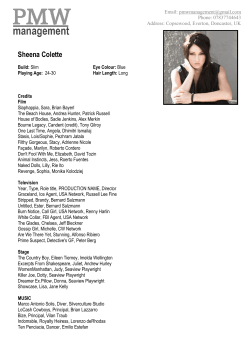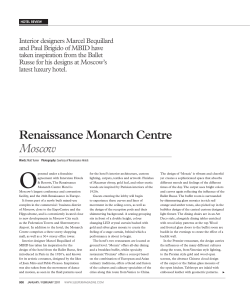
Young Girl in Profile in Renaissance Dress
Young Girl in Profile in Renaissance Dress - Wikipedia, the free encyclopedia
2/1/12 7:17 PM
Young Girl in Profile in Renaissance Dress
From Wikipedia, the free encyclopedia
Young Girl in Profile in Renaissance Dress, best known as "La Bella
Principessa", also called Profile of a Young Fiancée (Italian: La Bella
Principessa), is a portrait whose attribution to Leonardo da Vinci is a
matter of contention.[1] The portrait is a mixed media drawing in chalk,
pen, ink and wash tint on vellum, measuring 33 cm x by 22 cm
(approximately 13 inches tall and 9 inches wide).[2]
It was purchased by the present owner in 2007. Lumière Technology in
Paris performed a multi-spectral digital scan of the work.[3] The spectral
images were analysed by Peter Paul Biro, a forensic art examiner,[4] who
discovered a fingerprint "highly comparable" to a fingerprint on the
unfinished St. Jerome in the Wilderness.[4]
The first study of the drawing was published by Dr. Cristina Geddo in
Artes.[5] Geddo attributes this work to Leonardo based not only on
stylistic considerations, extremely high quality and left-handed hatching,
but also on the evidence of the execution technique using black, white
and red chalks (trois crayons or pastel). In fact, Leonardo was the first
artist in Italy to use pastels, a drawing technique he had learned from the
French artist Jean Perréal whom he met in Milan at the end of the
fifteenth century. Leonardo himself acknowledges his debt to Perreal in
the Codex Atlanticus. Geddo also points out that the "coazzone" of the
sitter's hairstyle was fashionable during the same period.
Young Girl in Profile in Renaissance
Dress or "La Bella Principessa".
Martin Kemp, Emeritus Research Professor in the History of Art at
Oxford University, has written a book about the drawing and has
identified the girl as Bianca Sforza, the daughter of Ludovico Sforza and
his mistress Bernardina de Corradis, and renamed the portrait La Bella
Principessa, though Sforza ladies were not princesses.
Contents
1 Attribution to Leonardo
2 Disagreement with attribution
3 Provenance
4 References
5 Further reading
6 External links
http://en.wikipedia.org/wiki/Young_Girl_in_Profile_in_Renaissance_Dress
Young Girl in Profile in Renaissance
Dress, fingerprint encircled.
Page 1 of 5
Young Girl in Profile in Renaissance Dress - Wikipedia, the free encyclopedia
2/1/12 7:17 PM
Attribution to Leonardo
This is a summary of Kemp's book, published in March 2009 by Hodder & Stoughton:
The portrait of a young lady on the cusp of maturity shows her with the fashionable costume and hairstyle of a
Milanese court lady in the 1490s. By process of elimination involving the inner group of young Sforza women,
Kemp concluded that she is probably Bianca Sforza, the illegitimate (but later legitimized) daughter of
Ludovico Sforza ("Il Moro"), duke of Milan. In 1496, when Bianca was no more than 13, she was married to
Galeazzo Sanseverino, captain of the duke’s Milanese forces. Galeazzo was a patron of Leonardo. Tragically,
Bianca was dead within months of her marriage, suffering from a stomach complaint (possibly an ectopic
pregnancy). Milanese princesses were the dedicatees of books of poetry on vellum: such a portrait of a "beloved
lady" would have made a suitable frontispiece or main illustration for a set of verses produced on the occasion
of her marriage or death (most probably the latter).
The physical and scientific evidence from multispectral analysis and first-hand study of La Bella Principessa
may be summarized as follows:
The technique of the portrait is black, red and white chalks (trois crayons, a French medium), with
pen and ink.
The drawing and hatching was carried out entirely by a left-handed artist, as we know Leonardo to
have been.
There are significant pentimenti throughout.
The portrait is characterized by particularly subtle details, such as the relief of the ear hinted at below
the hair, and the amber of the sitter’s iris.
There are strong stylistic parallels with the Windsor silverpoint drawing of A Woman in Profile,
which, like other head studies by Leonardo, features comparable delicate pentimenti to the profile.
The members of the Sforza family were always portrayed in profile, whereas Ludovico’s mistresses
were not.
The proportions of the head and face reflect the rules that Leonardo articulated in his notebooks.
The interlace or knotwork ornament in the costume and caul corresponds to patterns that Leonardo
explored in other works and in the logo designs for his Academy.
The portrait was executed on vellum—unknown in the surviving work of Leonardo—though we
know from his writings that he was interested in the French technique of dry colouring on parchment
(vellum). He specifically noted that he should ask the French artist, Jean Perréal, who was in Milan in
1494 and perhaps on other occasions, about the method of colouring in dry chalks.
The format of the vellum support is that of a !2 rectangle, a format used for several of his portraits.
The vellum sheet was cut from a codex, probably a volume of poetry of the kind presented to mark
major events in the Sforza women’s lives.
The vellum bears a fingerprint near the upper left edge, which features a distinctive "island" ridge and
closely matches a fingerprint in the unfinished St Jerome by Leonardo. It also includes a palmprint in
the chalk pigment on the neck of the sitter, which is characteristic of Leonardo's technique.
The green of the sitter’s costume was originally obtained with a simple diffusion of black chalk
applied on top of the yellowish tone of the vellum support.
The nuances of the flesh tints were also achieved by exploiting the tone of the vellum and allowing it
to show through the transparent media.
There are noteworthy similarities between La Bella and the portrait of Cecilia Gallerani, including the
http://en.wikipedia.org/wiki/Young_Girl_in_Profile_in_Renaissance_Dress
Page 2 of 5
Young Girl in Profile in Renaissance Dress - Wikipedia, the free encyclopedia
2/1/12 7:17 PM
handling of the eyes, the modelling of flesh tones using the palm of the hand, the intricacy of the
patterns of the knotwork ornament and the treatment of the contours.
The now somewhat pale original hatching in pen and ink was retouched in ink in a later restoration,
which is far less fluid, precise and rhythmic.
There have been some diplomatic re-touchings over the years, most extensively in the costume and
headdress, but the restoration has not affected the expression and physiognomy of the face to a
significant degree, and has not seriously affected the overall impact of the portrait.
Disagreement with attribution
A number of Leonardo experts have concurred with Kemps's conclusions, including Carlo Pedretti, Nicholas
Turner, Alessandro Vezzosi, who is the director of the Museo Ideale Leonardo Da Vinci in Vinci, Italy, Dr.
Christina Geddo, Dr. Claudio Strinati of the Italian Ministry of Culture, and Mina Gregori, professor emerita at
the University of Florence.[1][6][7]
However, the attribution to Leonardo is not unchallenged, with other connoisseurs expressing
reservations.[1][6][8] Among the reasons for doubt are the lack of provenance prior to the 20th century – unusual
given Leonardo's renown dating from his own lifetime, as well as the fame of the purported subject's family[8] –
and the fact that vellum lasts for centuries, which would facilitate a forger's acquisition of old sheets.[1] Further,
there exist around 4,000 drawings by Leonardo, none of which feature vellum as a surface.[8] Leonardo scholar
Pietro C. Marani discounts the significance of the drawing being made by a left-handed artist, noting that
imitators of Leonardo's work have emulated this characteristic in the past.[8] Marani is also troubled by the
vellum surface, 'monotonous' detail, use of colored pigments in specific areas, lack of craquelure, and firmness
of touch.[8] A museum director who wished to remain anonymous believes the drawing is "a screaming 20thcentury fake," and finds the damages and repair to the drawing suspicious.[8] Planning an exhibition of
Leonardo's work, Nicholas Penny, director of the National Gallery, said simply "We have not asked to borrow
it."[8]
Klaus Albrecht Schröder, director of the Albertina, Vienna, said "No one is convinced it is a Leonardo," and
David Ekserdjian, a scholar of 16th century Italian drawings, wrote that he suspects the work is a
"counterfeit."[1] Neither Carmen Bambach of the Metropolitan Museum of Art, one of the primary scholars of
Leonardo's drawings, nor Everett Fahy, her colleague at the Metropolitan, accepts the attribution to
Leonardo.[1][8]
Several forensic experts on fingerprints have discounted Biro's conclusions, finding the partial fingerprint taken
from the drawing too poorly detailed to offer conclusive evidence.[1] Biro's description of the print as being
"highly comparable" to a known fingerprint of Leonardo's has similarly been discounted by fingerprint
examiners as being too vague an assessment to establish authorship.[1] When asked if he may have been
mistaken to suggest that the fingerprint was Leonardo's, Biro answered "It's possible. Yes."[1]
Noting the lack of inclusion of dissenting opinion in Kemp's publication, Richard Dorment wrote in the
Telegraph: "Although purporting to be a work of scholarship, his book has none of the balanced analysis you
would expect from such an acclaimed historian. For La Bella Principessa, as he called the girl in the study, is
http://en.wikipedia.org/wiki/Young_Girl_in_Profile_in_Renaissance_Dress
Page 3 of 5
Young Girl in Profile in Renaissance Dress - Wikipedia, the free encyclopedia
2/1/12 7:17 PM
not art history – it is advocacy."[8]
Fred R. Kline, an independent art historian known for discoveries of "lost art" among the Nazarene Brotherhood
of German painters[9] suggested in a front page article in The Santa Fe New Mexican,[10] that the creator of the
drawing may actually be Julius Schnorr von Carolsfeld (1794-1872), circa 1820, one of the Nazarene
Brotherhood working in Rome during the early 19th century who revived the styles and subjects of Italian
Renaissance masters. Kline found a related drawing on vellum by Schnorr, Half-nude Female, in the collection
of the State Art Museum in Mannheim, Germany, as well as two other drawings on vellum by Schnorr. Kline
suggests that La Bella Principessa depicts the same model who appears in the Mannheim drawing, but an
idealized version of her in the manner of a Renaissance engagement portrait.
Comparative material-testing of the vellum supports of the Mannheim Schnorr and "La Bella Principessa" may
occur in a New York federal court in the pending lawsuit, Marchig v. Christie's, brought on by the original
owner of "La Bella Principessa" who is accusing Christie's of negligent misattribution and other damages.
Christie's had auctioned Mrs. Marchig's drawing in 1998 as "German School, early 19th century".
Provenance
The work appeared in a Christie's sale on January 1, 1998, in New York, called Young Girl in Profile in
Renaissance Dress and catalogued as early 19th-century German,[11][12] when it sold for $19,000. It was sold
again in 2007 and was exhibited in And there was Light in Eriksberg, Gothenburg in Sweden,[13] estimated to
be worth more than $160 million.[14][15][16][17][18][19]
References
1. ^ a b c d e f g h i "The Mark of a Masterpiece" (http://www.newyorker.com/reporting/2010/07/12/100712fa_fact_grann?
currentPage=all) by David Grann, The New Yorker, Vol. LXXXVI, No. 20, July 12 & 19, 2010, ISSN 0028792X
(http://www.worldcat.org/search?fq=x0:jrnl&q=n2:0028792X)
2. ^ Adams, James (14 October 2009). "His Prints Were All Over It" (http://www.theglobeandmail.com/report-onbusiness/small-business/next-big-thing/his-prints-were-all-over-it/article1322645/) . The Globe and Mail.
http://www.theglobeandmail.com/report-on-business/small-business/next-big-thing/his-prints-were-all-overit/article1322645/. Retrieved 15 October 2009.
3. ^ McLean, Jesse (13 October 2009). "$19,000 Portrait Could Be Lost Da Vinci Work"
(http://www.thestar.com/news/world/article/709317---19-000-portrait-could-be-lost-davinci-work) . Toronto Star.
http://www.thestar.com/news/world/article/709317---19-000-portrait-could-be-lost-davinci-work. Retrieved 13 October
2009.
4. ^ a b Pidd, Helen (13 October 2009). "New Leonardo da Vinci painting 'discovered'"
(http://www.guardian.co.uk/artanddesign/2009/oct/13/leonardo-da-vinci-painting-discovered) . The Guardian (London).
http://www.guardian.co.uk/artanddesign/2009/oct/13/leonardo-da-vinci-painting-discovered. Retrieved 13 October 2009.
5. ^ Geddo, Cristina. "Il pastello ritrovato: un nuovo ritratto di Leonardo?", Artes, Vol. 14, 2008–2009, p. 63–87
6. ^ a b Esterow, Milton. "The Real Thing?" (http://www.artnews.com/issues/article.asp?art_id=2815) , in ARTnews
7. ^ Letter from Peter Silverman, The New Yorker, August 2, 2010, 3.
8. ^ a b c d e f g h i Dorment, Richard "La Bella Principessa: a £100m Leonardo, or a copy?"
(http://www.telegraph.co.uk/culture/art/7582591/La-Bella-Principessa-a-100m-Leonardo-or-a-copy.html) , The Daily
Telegraph, 12 April 2010]
http://en.wikipedia.org/wiki/Young_Girl_in_Profile_in_Renaissance_Dress
Page 4 of 5
Young Girl in Profile in Renaissance Dress - Wikipedia, the free encyclopedia
2/1/12 7:17 PM
9. ^ Geary, David. "An Art Explorer Finds the Real Creator of Works", New York Times, April 2, 2002
10. ^ Sharpe, Tom. "Case Closed on da Vinci Mystery?", The Santa Fe New Mexican, September 25, 2010
11. ^ Lot 402, Sale 8812 ("old master drawings") (http://www.christies.com/LotFinder/lot_details.aspx?
intObjectID=473187) at Christie's. Retrieved 15 October 2009.
12. ^ Neuer da Vinci entdeckt? – Teure Prinzessin (http://www.sueddeutsche.de/kultur/551/490923/text/) Süddeutsche
Zeitung, 14 October 2009. Retrieved 15 October 2009.
13. ^ "La Bella Principessa på plats" (http://svt.se/2.34007/1.1932778/la_bella_principessa_pa_plats?
lid=senasteNytt_1765014&lpos=rubrik_1932778) , March 18, 2010
14. ^ "Fingerprint points to $19,000 portrait being revalued as £100m work by Leonardo da Vinci"
(http://www.antiquestradegazette.com/news/7311.aspx) , 12 October 2009
15. ^ "Fingerprint unmasks original da Vinci painting"
(http://www.cnn.com/2009/WORLD/europe/10/13/da.vinci.portrait.found/) . CNN. 13 October 2009.
http://www.cnn.com/2009/WORLD/europe/10/13/da.vinci.portrait.found/.
16. ^ "Finger points to new da Vinci art" (http://news.bbc.co.uk/1/hi/uk/8304021.stm) . BBC News. 13 October 2009.
http://news.bbc.co.uk/1/hi/uk/8304021.stm.
17. ^ Pidd, Helen (13 October 2009). "New Leonardo da Vinci painting 'discovered'"
(http://www.guardian.co.uk/artanddesign/2009/oct/13/leonardo-da-vinci-painting-discovered) . The Guardian (London).
http://www.guardian.co.uk/artanddesign/2009/oct/13/leonardo-da-vinci-painting-discovered.
18. ^ Adams, Stephen (12 October 2009). "Leonardo da Vinci picture 'worth millions' revealed by a fingerprint"
(http://www.telegraph.co.uk/culture/art/art-news/6309942/Leonardo-da-Vinci-picture-worth-millions-revealed-by-afingerprint.html) . The Daily Telegraph (London). http://www.telegraph.co.uk/culture/art/art-news/6309942/Leonardoda-Vinci-picture-worth-millions-revealed-by-a-fingerprint.html.
19. ^ Hoyle, Ben (13 October 2009). "Unrecognised Leonardo da Vinci portrait revealed by his fingerprint"
(http://entertainment.timesonline.co.uk/tol/arts_and_entertainment/visual_arts/article6872019.ece) . The Times (London).
http://entertainment.timesonline.co.uk/tol/arts_and_entertainment/visual_arts/article6872019.ece.
Further reading
O'Neill, Tom; Colla, Gianluca. Lady with a Secret: A Chalk-And-Ink Portrait May Be a $100 Million
Leonardo (http://ngm.nationalgeographic.com/2012/02/lost-da-vinci/o-neill-text) , National
Geographic Magazine, February 2012.
External links
PBS documentary film "Mystery of a Masterpiece" (52:52) PBS film "Mystery of the Masterpiece"
(52:52) (http://www.pbs.org/wgbh/nova/tech/mystery-masterpiece.html)
Retrieved from "http://en.wikipedia.org/w/index.php?
title=Young_Girl_in_Profile_in_Renaissance_Dress&oldid=474151073"
Categories:
Works by Leonardo da Vinci 1490s paintings Drawings
15th-century portraits
This page was last modified on 31 January 2012 at 03:24.
Text is available under the Creative Commons Attribution-ShareAlike License; additional terms may
apply. See Terms of use for details.
Wikipedia® is a registered trademark of the Wikimedia Foundation, Inc., a non-profit organization.
http://en.wikipedia.org/wiki/Young_Girl_in_Profile_in_Renaissance_Dress
Page 5 of 5
© Copyright 2025




















